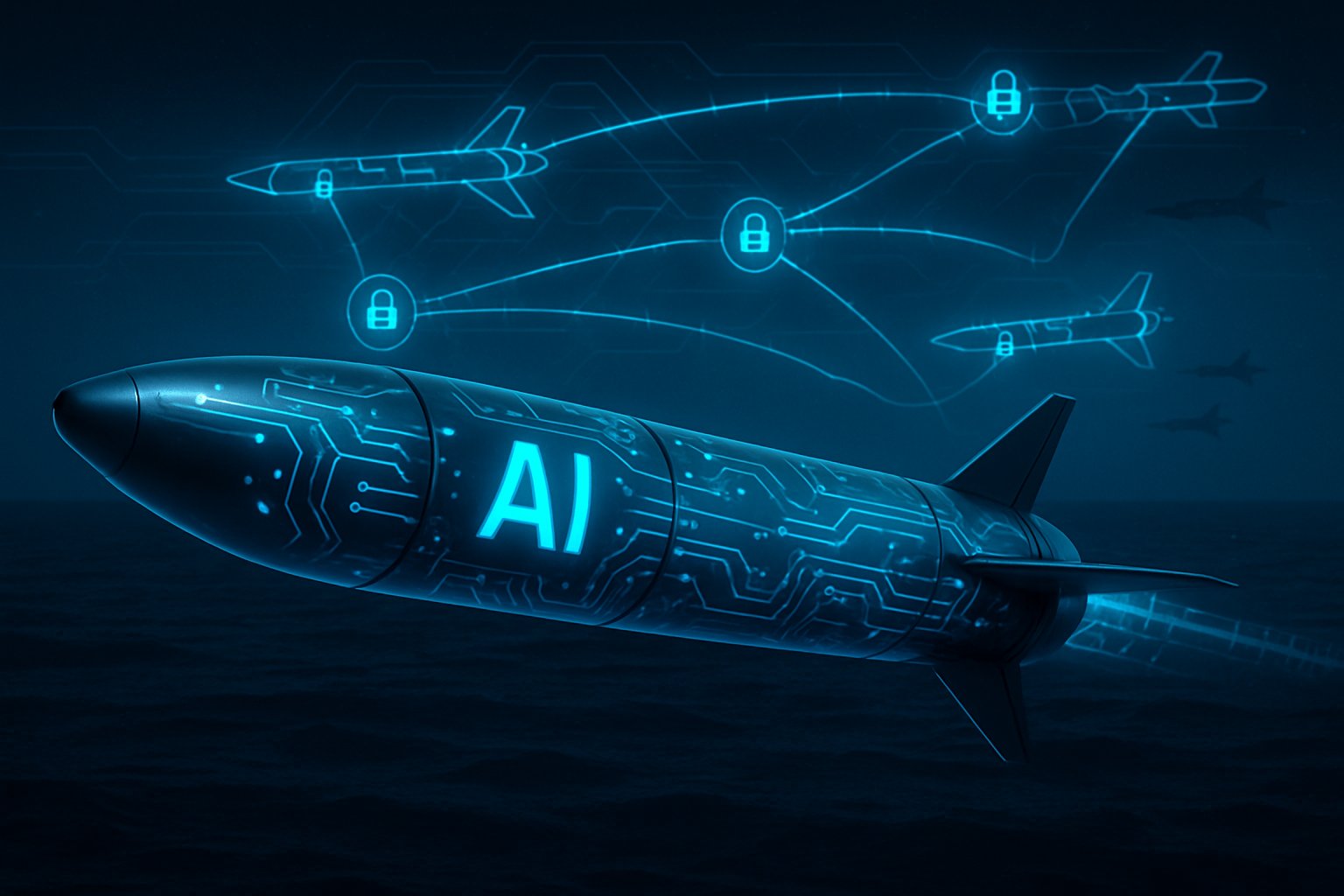
AI CERTS
5 hours ago
Japan’s AI missiles: cooperative salvos for naval defense
This concept reflects a global pivot toward cooperative weapons and hardened networks. However, Tokyo stresses strict human authority over lethal engagement. Analysts note the effort fits broader long-range modernization that includes upgraded Type-12 and ASM-3A missiles. The following analysis unpacks technical aims, policy safeguards, and industry stakes.
Program Overview And Context
Japan’s missile roadmap has quickened since 2024 as neighbors deploy larger fleets. Consequently, policymakers see a need for longer reach and smarter salvos. The new study focuses on coordinated weapons that outmaneuver layered ship defenses.

Additionally, the ¥200 million research line funds a three-year technology assessment under the Acquisition, Technology & Logistics Agency. Observers call the investment modest yet symbolic for Japan’s defense AI ambitions. In contrast, earlier missile projects concentrated on speed rather than cognition.
Tokyo plans to integrate the prospective AI missiles with existing Type-12 upgrade schedules. Furthermore, officials describe a phased test effort culminating in limited operational trials by fiscal 2029. Success could elevate regional deterrence without breaching constitutional limits.
In summary, political urgency and modest funding launch Japan’s cooperative salvo journey. However, technical hurdles remain significant.
The next section examines these engineering objectives in detail.
Technical Aims Under Study
Core objectives center on dynamic targeting, role assignment, and contested-spectrum survival. Therefore, engineers seek algorithms that let AI missiles share tracklets, fuel state, and seeker health in real time. Cooperative weapons must also replan paths if targets maneuver unexpectedly.
Moreover, designers will pair strike bodies with agile decoys and onboard jammers. This system-of-systems approach creates a blended wave supporting missile autonomy while overwhelming defenses. Such architecture mirrors United States LRASM concepts yet adapts to Japan’s naval geography.
Budget documents further highlight secure comms as a parallel workstream. Consequently, encryption, authentication, and low-probability-of-intercept waveforms will guard against spoofing. Fallback profiles ensure lethality even when datalinks collapse.
- Initial R&D budget: ¥200 million for fiscal 2026
- Assessment period: Three years under ATLA oversight
- AI missiles operational milestone: Fiscal 2029
- Reference range: Upgraded Type-12 class, roughly 1,000 km
- Human control: Engagement authorization remains centralized
These aims illustrate an ambitious yet bounded mandate. Nevertheless, success demands robust networking and autonomy models.
The following section explores those computational frameworks.
Networking And Autonomy Models
Researchers debate leader-follower versus distributed mesh coordination. In a leader-follower scheme, one missile guides the pack through concise directives. Conversely, a mesh lets every node vote on tasks, boosting resilience.
Furthermore, reinforcement learning and heuristic planners will test maneuver options inside digital twins before hardware flight. Such defense AI tooling accelerates iteration while letting humans review algorithmic choices. Cooperative weapons thereby evolve tactics without live-fire costs.
Yet compute limits inside slender airframes challenge advanced AI missiles during sustained operations. Engineers must balance processing power, thermal loads, and missile autonomy demands. Moreover, compact chips must resist electromagnetic pulses common in electronic warfare environments.
Architectural choices will shape cost, survivability, and update cadence. Consequently, security and ethics loom equally large.
The next section addresses those safeguards.
Security And Ethical Safeguards
Japan emphasizes human-in-the-loop oversight even while pursuing AI missiles. Therefore, kill authorization remains with operators monitoring secure comms dashboards. Paul Scharre notes this policy aligns with emerging international norms.
Meanwhile, cyber researchers plan multilayer encryption and rapid key rotation. These measures thwart interception or hijack attempts against AI missiles during electronic warfare exchanges. Additionally, redundant antennas and frequency hopping reduce single-point failures.
Professionals can deepen governance expertise through the AI Government Strategist™ certification. Moreover, such credentials support safer defense AI deployments and rigorous audit trails.
Security engineering and ethical doctrine proceed hand in hand. Nevertheless, industrial capacity will determine delivery speed.
The subsequent section reviews candidate contractors and global benchmarks.
Industrial And Global Comparators
Mitsubishi Heavy Industries appears the natural prime given its ASM-3A heritage. Additionally, smaller avionics houses may supply networking cards and secure comms firmware. Collaboration with U.S. LRASM teams could accelerate test data exchange. Its expertise in propulsion suits AI missiles requiring expanded onboard power.
In contrast, Israel’s Sea Breaker demonstrates parallel advances in missile autonomy and image-based seekers. Germany’s RAM Block 2B shows missile-to-missile links working today. Such comparators validate Japan’s roadmap and highlight export control constraints.
Industry analysts also track start-ups offering specialized cooperative weapons algorithms. Furthermore, research labs at universities refine robust defense AI models under Ministry grants. Open architecture standards will ease future upgrades across platforms.
Domestic primes and allied programs furnish technical blueprints and cautionary lessons. Consequently, strategic impact warrants detailed assessment.
The next section evaluates operational payoffs and risks.
Strategic Impact Assessment Ahead
Coordinated salvos raise penetration odds by saturating radars and splitting interceptors. Moreover, distributed sensing cuts blind spots created by electronic warfare smoke screens. Therefore, fewer launch assets can yield credible deterrence.
However, adversaries may counter with AI-assisted defenders and anti-network measures. Secure comms discipline thus becomes a decisive differentiator. Meanwhile, escalating autonomy could ignite legal debates over accountability.
Japan also signals resolve without exceeding defensive mandates. Consequently, AI missiles complement rather than replace crewed platforms, preserving alliance interoperability. Policymakers must still fund rigorous testing to avoid accidental escalation.
Strategic benefits look tangible yet fragile under cyber pressure. Nevertheless, disciplined rollout can balance innovation and restraint.
We conclude with final insights and recommended actions.
Conclusion And Next Steps
Japan’s emerging AI missiles program illustrates a pragmatic path toward smarter maritime defense. Moreover, layered investments in cooperative weapons, defense AI, missile autonomy, electronic warfare resilience, and secure comms form a coherent roadmap. Engineers must optimize networking, verify algorithms, and harden datalinks before fleet release. Policymakers should maintain human control and transparent oversight throughout trials. Professionals seeking to guide such efforts can enroll in the AI Government Strategist™ certification to master governance frameworks. Ultimately, disciplined innovation today will strengthen deterrence tomorrow. Act now by exploring advanced credentials and following ongoing program milestones.



